The Hajjar Regional Transpressive Shear Zone (Guemassa Massif, Morocco): Consequences on the Deformation of the Base-Metal Massive Sulfide Ore
Abstract
1. Introduction
2. The Hajjar Geological and Ore Deposit Framework
3. Surface Structural Data
4. Sub-Surface Structural Data from the Hajjar Deposit
4.1. Strain Pattern and Meso-Scale Structures
4.2. The N to NNE-Trending High Strain Corridors
4.3. The NE to ENE-Trending High Strain Corridors
4.4. Microstructures and Textures in the Host Rocks
4.5. Microstructures and Textures in Sulfides
5. Interpretation
5.1. Hajjar Mine and N’Fis Block: One Single Foliation (Not Two)
5.2. The Hajjar Mine is Located within a Regional-Scale Shear Zone
5.3. Ore Deformation and Remobilization
6. Discussion: Toward an Integrated Tectono-Metamorphic Model for the MSD-Bearing Jebilet and Guemassa Massifs
7. Conclusion
Author Contributions
Funding
Acknowledgments
Conflicts of Interest
References
- Cawood, P.A.; Hawkesworth, C.J. Temporal relations between mineral deposits and global tectonic cycles. In Ore Deposits in an Evolving Earth; Jenkin, G.R.T., Lusty, P.A.J., Mcdonald, I., Smith, M.P., Boyce, A.J., Wilkinson, J.J., Eds.; Geological Society of London: London, UK, 2013; pp. 9–21. [Google Scholar]
- Graf, J.; Skinner, B. Strength and deformation of pyrite and pyrrhotite. Econ. Geol. 1970, 65, 206–215. [Google Scholar] [CrossRef]
- Marshall, B.; Gilligan, L.B. An introduction to remobilisation: information from ore-body geometry and experimental considerations. Ore Geol. Rev. 1987, 2, 87–131. [Google Scholar]
- Marshall, B.; Spry, P.G. Discriminating between regional metamorphic remobilization and syntectonic emplacement in the genesis of massive sulfide ores. Rev. Econ. Geol. 1998, 11, 39–80. [Google Scholar]
- Marignac, C.; Diagana, B.; Cathelineau, M.; Boiron, M.-C.; Banks, D.; Fourcade, S.; Vallance, J. Remobilisation of base metals and gold by Variscan metamorphic fluids in the south Iberian pyrite belt: evidence from the Tharsis VMS deposit. Chem. Geol. 2003, 194, 143–165. [Google Scholar] [CrossRef]
- Chauvet, A.; Onézime, J.; Charvet, J.; Barbanson, L.; Faure, M. Syn- to late-tectonic stockwork emplacement within the spanish section of the iberian pyrite belt: Structural, textural, and mineralogical constraints in the tharsis and la zarza areas. Econ. Geol. 2004, 99, 1781–1792. [Google Scholar] [CrossRef]
- Barrie, C.D.; Boyle, A.P.; Prior, D.J. An analysis of the microstructures developed in experimentally deformed polycrystalline pyrite and minor sulphide phases using electron backscatter diffraction. J. Struct. Geol. 2007, 29, 1494–1511. [Google Scholar] [CrossRef]
- Barrie, C.D.; Boyle, A.P.; Cook, N.J.; Prior, D.J. Pyrite deformation textures in the massive sulfide ore deposits of the Norwegian Caledonides. Tectonophysics 2010, 483, 269–286. [Google Scholar] [CrossRef]
- Barrie, C.D.; Peare, M.A.; Boyle, A.P. Reconstructing the pyrite deformation mechanism map. Ore Geol. Rev. 2011, 39, 265–276. [Google Scholar] [CrossRef]
- Reddy, S.M.; Hough, R.M. Microstructural evolution and trace element mobility in Witwatersrand pyrite. Contrib. Mineral. Petrol. 2013, 166, 1269–1284. [Google Scholar] [CrossRef]
- Bernard, A.J.; Maier, O.W. Aperçus sur les amas sulfurés Massifs des hercynides Marocaines. Miner. Depos. 1988, 23, 104–114. [Google Scholar] [CrossRef]
- Hibti, M. Les amas Sulfurés des Guemassa et des Jebilet (Meseta Sud-Occidentale, Maroc): Temoins de L’hydrothermalisme Précoce dans le Bassin Mesetien. Ph.D Thesis, University Cadi Ayyad, Marrakech, Morocco, 2001. [Google Scholar]
- Belkabir, A.; Gibson, H.L.; Marcoux, E.; Lentz, D.; Rziki, S. Geology and wall rock alteration at the Hercynian Draa Sfar Zn–Pb–Cu massive sulphide deposit, Morocco. Ore Geol. Rev. 2008, 33, 280–306. [Google Scholar] [CrossRef]
- Marcoux, E.; Belkabir, A.; Gibson, H.L.; Lentz, D.; Ruffet, G. Draa Sfar, Morocco: A Visean (331 Ma) pyrrhotite-rich, polymetallic volcanogenic massive sulphide deposit in a Hercynian sedimentdominant terrane. Ore Geol. Rev. 2008, 33, 307–328. [Google Scholar] [CrossRef]
- Moreno, C.; Sáez, R.; González, F.; Almodóvar, G.; Toscano, M.; Playford, G.; Alansari, A.; Rziki, S.; Bajddi, A. Age and depositional environment of the Draa Sfar massive sulfide deposit, Morocco. Miner. Depos. 2008, 43, 891–911. [Google Scholar] [CrossRef]
- Ben aissi, l. Contribution à L’étude Gîtologique des Amas Sulfurés Polymétalliques de Draa Sfar et de Koudiat Aïcha: Comparaison avec les Gisements de Ben Slimane et de Kettara (Jebilet Centrales, Maroc Hercynien). Ph.D Thesis, University Cadi Ayyad, Marrakech, Morocco, 2008. [Google Scholar]
- Lotfi, F.; Belkabir, A.; Brown, A.C.; Marcoux, E.; Brunet, S.; Maacha, L. Geology and Mineralogy of the Hercynian Koudiat Aïcha Polymetallic (Zn-Pb-Cu) Massive Sulfide Deposit, Central Jebilet, Morocco. Explor. Min. Geol. 2008, 17, 145–162. [Google Scholar] [CrossRef]
- Essaifi, A. Relations entre Magmatisme-Déformation et al.tération Hydrothermale: L’exemple des Jebilet Centrales (Hercynien, Maroc). Ph.D Thesis, Unversity of RennesI, Rennes, France, 1995. [Google Scholar]
- Essaifi, A.; Hibti, M. The hydrothermal system of Central Jebilet (Variscan Belt, Morocco): A genetic association between bimodal plutonism and massive sulphide deposits? J. Afr. Earth Sci. 2008, 50, 188–203. [Google Scholar] [CrossRef]
- Essaifi, A.; Goodenough, K.M.; Lusty, P.A.J.; Outigua, A. Microstructural and Textural Evidence for Protracted Polymetallic Sulphide Mineralization in the Jebilet Massif (Variscan Belt of Morocco). Min. Resour. Sustain. World 2015, 1–5, 1603–1606. [Google Scholar]
- Lusty, P.A.J.; Goodenough, K.M.; Essaifi, A.; Maacha, L. Developing the lithotectonic framework and model for sulfide mineralization in the Jebilet Massif, Morocco: implications for regional exploration. In Mineral Resources in a Sustainable World, Proceedings of the 13th Biennial SGA Meeting, Nancy, France, 24–27 August 2015; André-Mayer, A.S., Cathelineau, M., Muchez, P.h., Pirard, E., Sindern, S., Eds.; Society for Geology Applied to Mineral Deposits (SGA): Genéve, Switzerland, 2015; pp. 1635–1638. [Google Scholar]
- N’Diaye, I.; Essaifi, A.; Dubois, M.; Lacroix, B.; Goodenough, K.M.; Maacha, L. Fluid flow and polymetallic sulfide mineralization in the Kettara shear zone (Jebilet Massif, Variscan Belt, Morocco). J. Afr. Earth Sci. 2016, 119, 17–37. [Google Scholar] [CrossRef]
- Hibti, M. L’amas Sulfuré de Hajjar, Contexte Géologique de mie en Place et déformations Superposées (Haouz de Marrakech, Méseta Sudoccidentale, Maroc). Ph.D Thesis, University Cadi Ayyad, Marrakech, Morocco, 1993. [Google Scholar]
- Zouhry, S. Étude Métallogénique D’un amas Sulfuré viséen à Zn Pb Cu: cas de Hajar, Guemassa, Maroc. Ph.D Thesis, Ecole polytechnique de Montréal, Montréal, Canada, 1999. [Google Scholar]
- Hibti, M.; Marignac, C. The Hajjar deposit of Guemassa (SW Meseta, Morocco): A metamorphosed syn-sedimentary massive sulfide ore body of the Iberian type of volcano-sedimentary massive sulfide deposits. In Mineral Deposits at the Beginning of the 21st Century, Proceedings of the Joint Sixth Biennial SGA-SEG Meeting, Krakow, Poland, 26–29 August 2001; A.A. Balkema: Lisse, The Netherlands, 2001; pp. 281–284. [Google Scholar]
- Delchini, S. Etude Tectono-Thermique D’un Segment Orogénique Varisque à Histoire GéOlogique Complexe: Analyse Structurale, Géochronologique et Thermique du Massif des Jebilet, de L’extension à la Compression. Ph.D Thesis, University of Orléans, Orléans, France, 2018. [Google Scholar]
- Delchini, S.; Lahfid, A.; Ramboz, C.; Branquet, Y.; Maacha, L. New Peak Temperature Constraints using RSCM Geothermometry on the Hajjar Zn-Pb-Cu Mine and its Surroundings (Guemassa Massif, Morocco). In Proceedings of the 13th SGA Biennial Meeting, Nancy, France, 24–27 August 2015. [Google Scholar]
- Delchini, S.; Lahfid, A.; Plunder, A.; Michard, A. Applicability of the RSCM geothermometry approach in a complex tectono-metamorphic context: The Jebilet Massif case study (Variscan Belt, Morocco). Lithos 2016, 256, 1–12. [Google Scholar] [CrossRef]
- Haimmeur, J. Contribution à L’étude de L’environnement Volcano-Sédimentaire et du Minerai de Douar Lahjar (Guemassa, Maroc), Lithologie, Paléo-Volcanisme, Géochimie et Métallogénie. Ph.D Thesis, École Nationale Supérieure de Géologie, Nancy, France, 1988. [Google Scholar]
- Raqiq, H. Le bassin Carbonifère des Guemassa (Meseta Sud occidentale, Maroc): Lithostratigraphie, sédimentologie et évolution structurale. Ph.D Thesis, University Cadi Ayyad, Marrakech, Morocco, 1997. [Google Scholar]
- Ouadjou, A. Pétrographie, Géochimie et Structure des Roches Magmatiques Antéschisteuses des Massifs Hercyniens des Guemassa et Souktana. Ph.D Thesis, University Cadi Ayyad, Marrakech, Morocco, 1997. [Google Scholar]
- Ed Debi, A.; Saquaque, A.; Kersit, M.; Chbiti, A. L’amas sulfuré de Hajar (Guemassa, Maroc). Chronique de la Recherche Minière 1998, 531–532, 45–54. [Google Scholar]
- Watanabe, Y. 40Ar/39Ar geochronologic constraints on the timing of massive sulfide and vein-Type Pb-Zn mineralization in the Western Meseta of Morocco. Econ. Geol. 2002, 97, 147–157. [Google Scholar] [CrossRef]
- Soulaimani, A. L’évolution structurale des Massifs hercyniens du Haouz de Marrakech: Guemassa- N’fis (Maroc). Ph.D Thesis, University Cadi Ayyad, Marrakech, Morocco, 1991. [Google Scholar]
- Dias, R.; Hadani, M.; Leal Machado, I.; Adnane, N.; Hendaq, Y.; Madih, K.; Matos, C. Variscan structural evolution of the western High Atlas and the Haouz plain (Morocco). J. Afr. Earth Sci. 2011, 61, 331–342. [Google Scholar] [CrossRef]
- Hoepffner, C.; Soulaimani, A.; Piqué, A. The Moroccan Hercynides. J. Afr. Earth Sci. 2005, 43, 144–165. [Google Scholar] [CrossRef]
- Saadi, M.; Hilali, E.A.; Bensaîd, M.; Boudda, A.; Dahmani, M. Carte géologique du Maroc, échelle 1:1 000 000. Notes Mém. Serv. Géol. Maroc. 1985. Available online: https://geodata.mit.edu/catalog/mit-gfcc2renabn5c (accessed on 6 October 2018).
- Pedersen, F.D. Remobilization of the massive sulfide ore of the Black Angel Mine, central West Greenland. Econ. Geol. 1980, 75, 1022–1041. [Google Scholar] [CrossRef]
- Maiden, K.J.; Chimimba, L.R.; Smalley, T.J. Cuspate ore-wall rock interfaces, piercement structures and the localization of some sulfide ores in deformed sulfide deposits. Econ. Geol. 1986, 81, 1464–1472. [Google Scholar] [CrossRef]
- Plimer, I.R. Remobilization in high-grade metamorphic environments. Ore Geol. Rev. 1987, 2, 231–245. [Google Scholar] [CrossRef]
- Gu, L.; Zheng, Y.; Tang, X.; Zaw, K.; Della-Pasque, F.; Wu, C.; Tian, Z.; Lu, J.; Li, X.; Yang, F.; et al. Copper, gold and silver enrichment in ore mylonites within massive sulphide orebodies at Hongtoushan VHMS deposit, NE China. Ore Geol. Rev. 2007, 30, 1–29. [Google Scholar] [CrossRef]
- Aarab, E.M.; Beauchamp, J. Le magmatisme carbonifère pré-orogénique des Jebilet centrales (Maroc). Précisions pétrographiques et sédimentaires. Implications géodynamiques. CR Acad. Sci. Paris 1987, 304, 169–174. [Google Scholar]
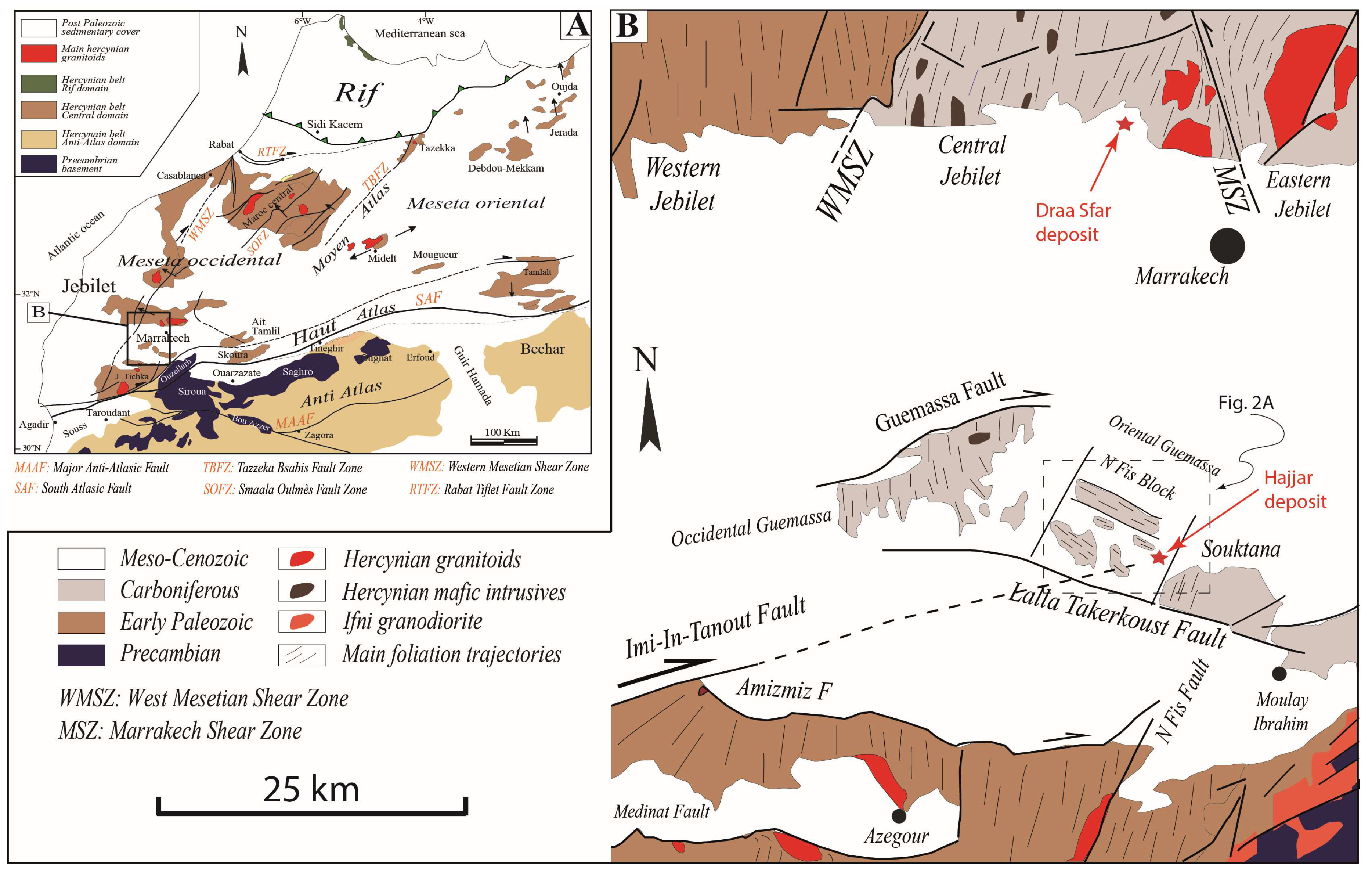

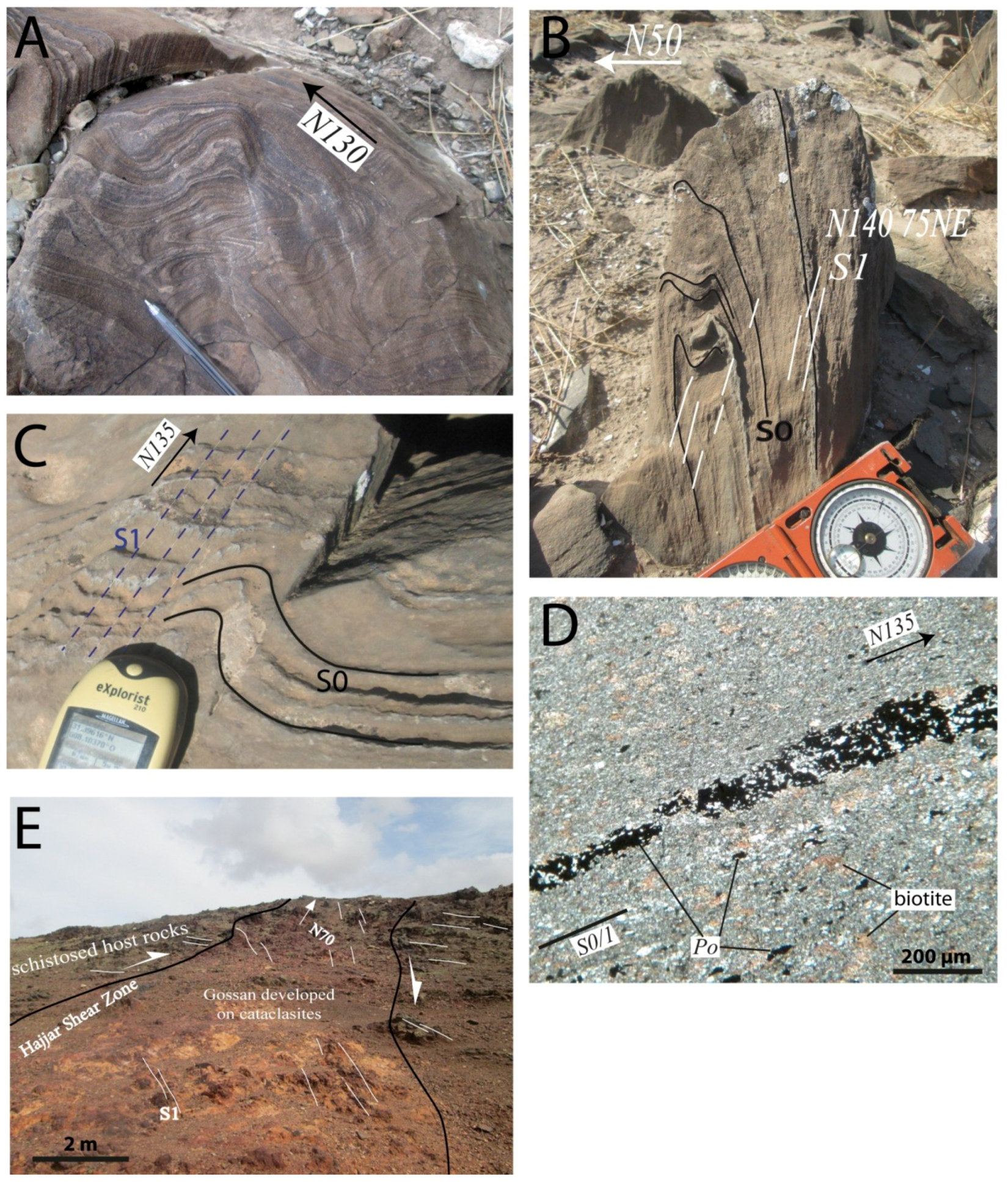
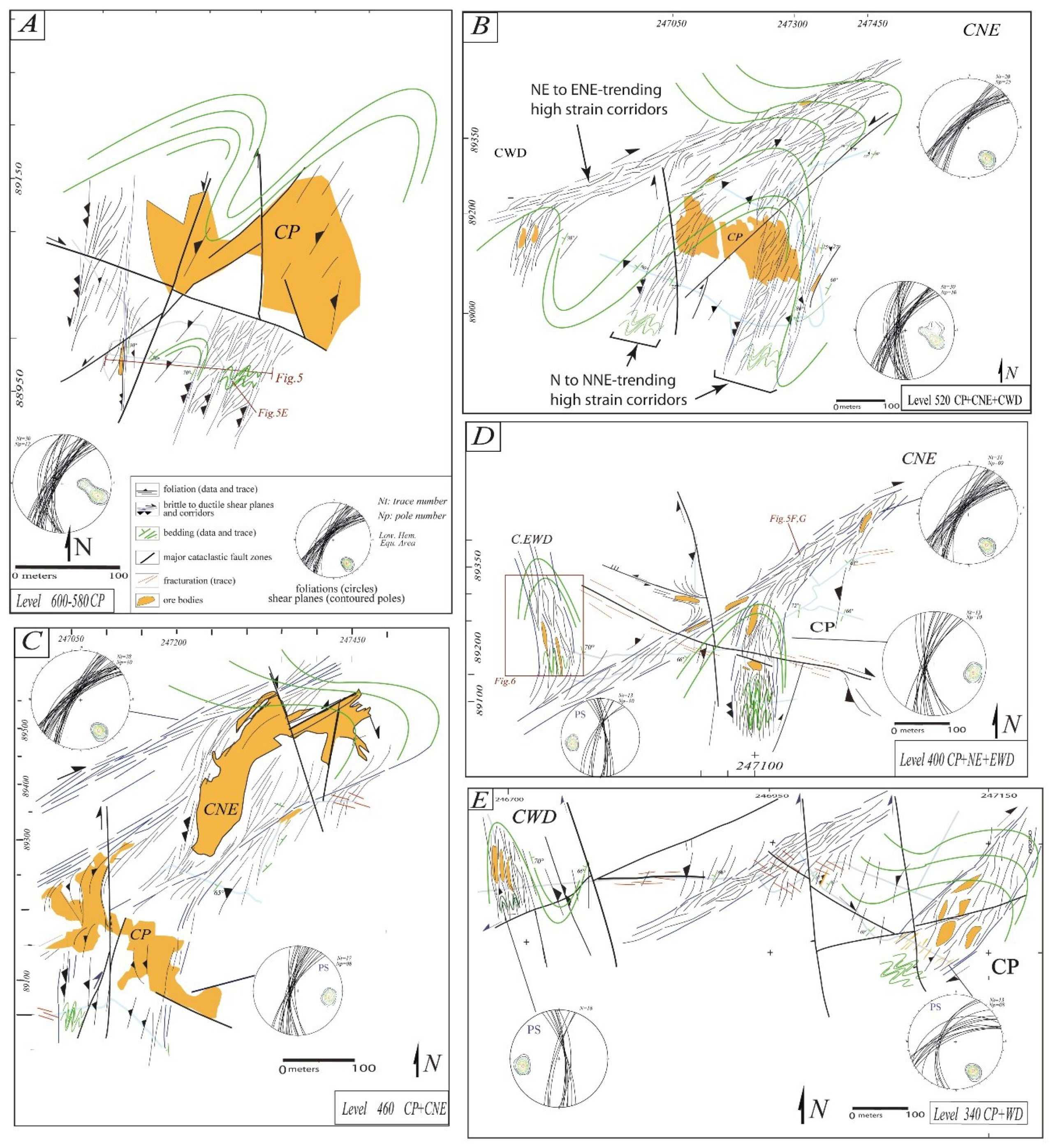
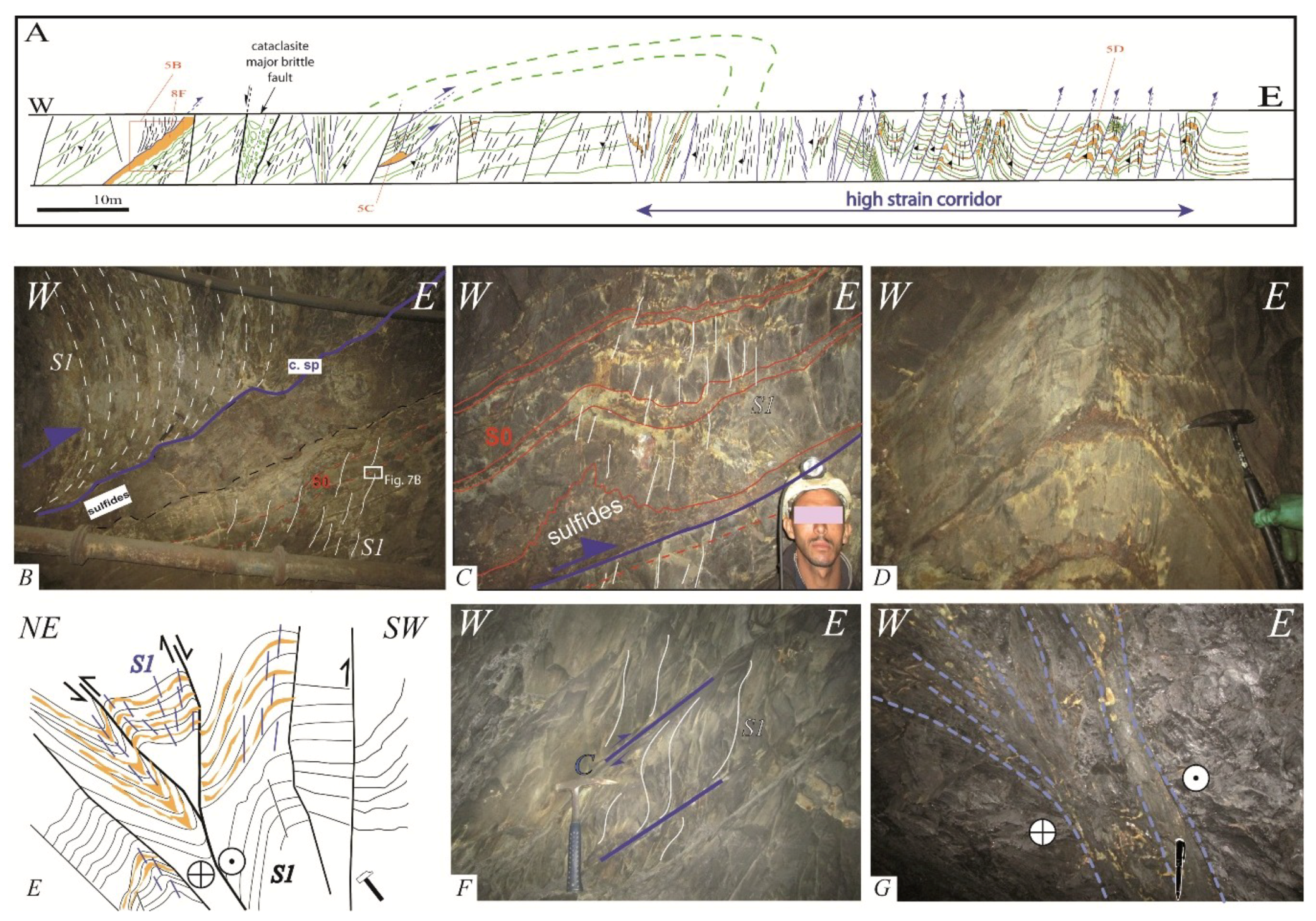
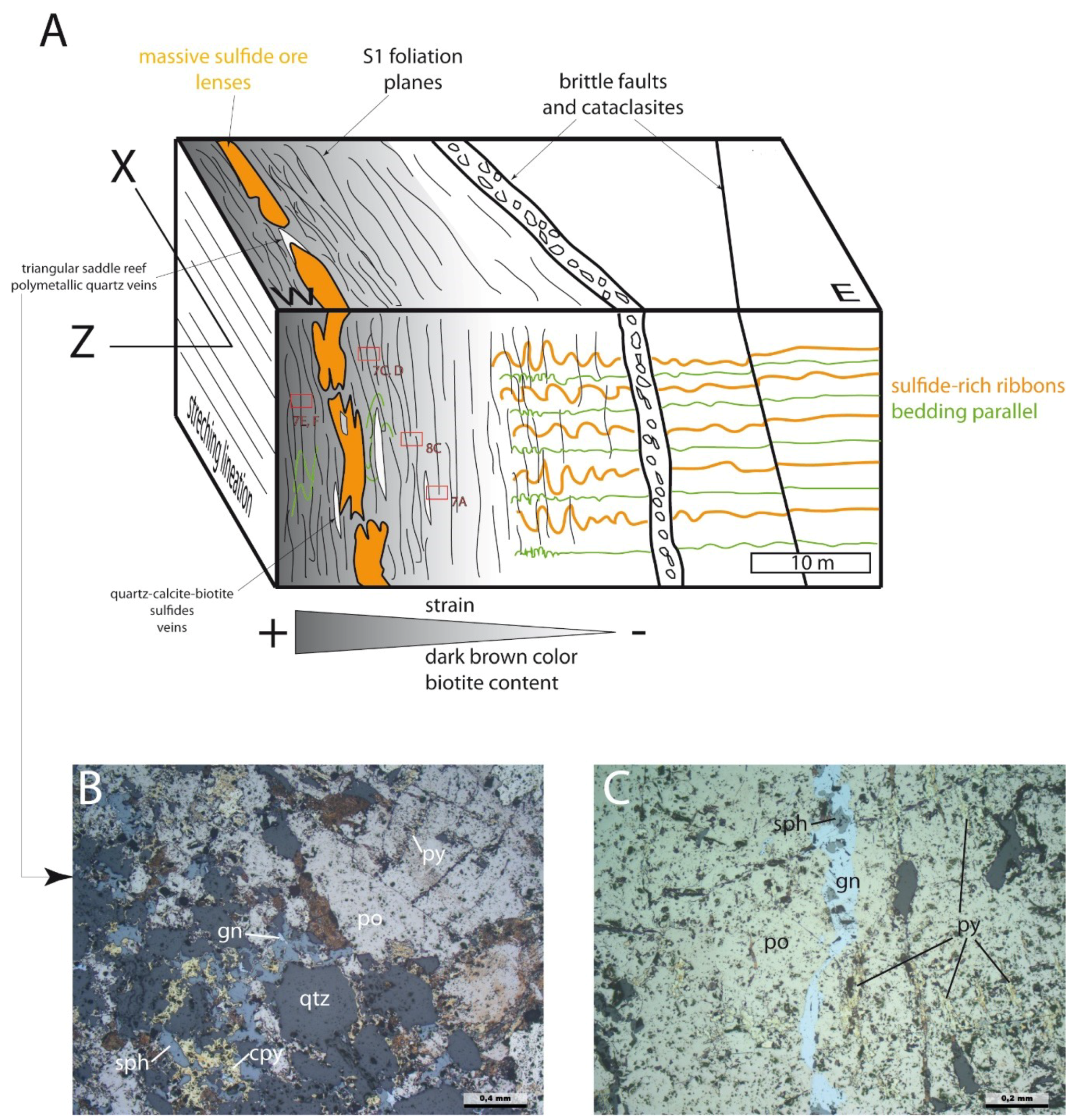
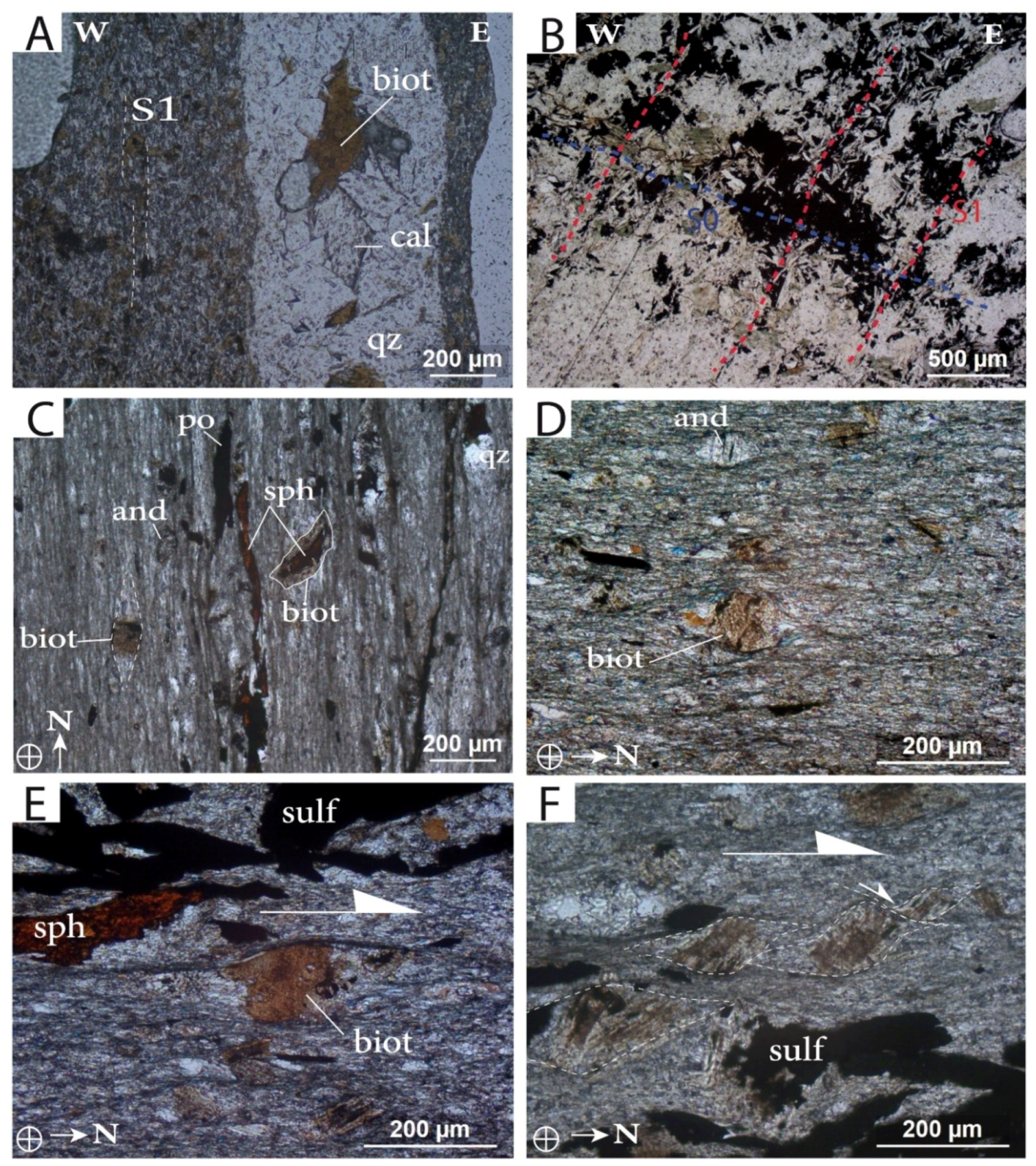
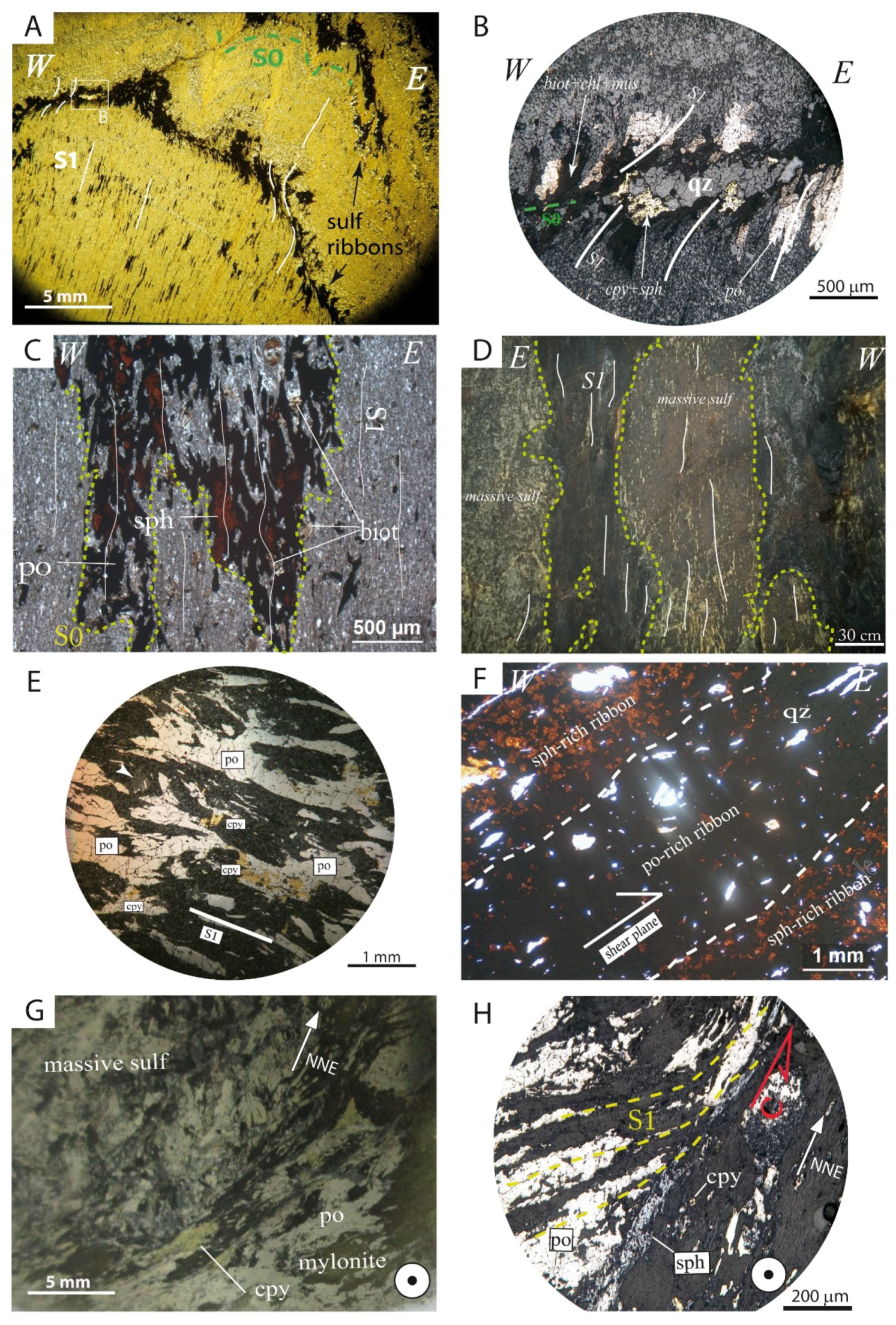
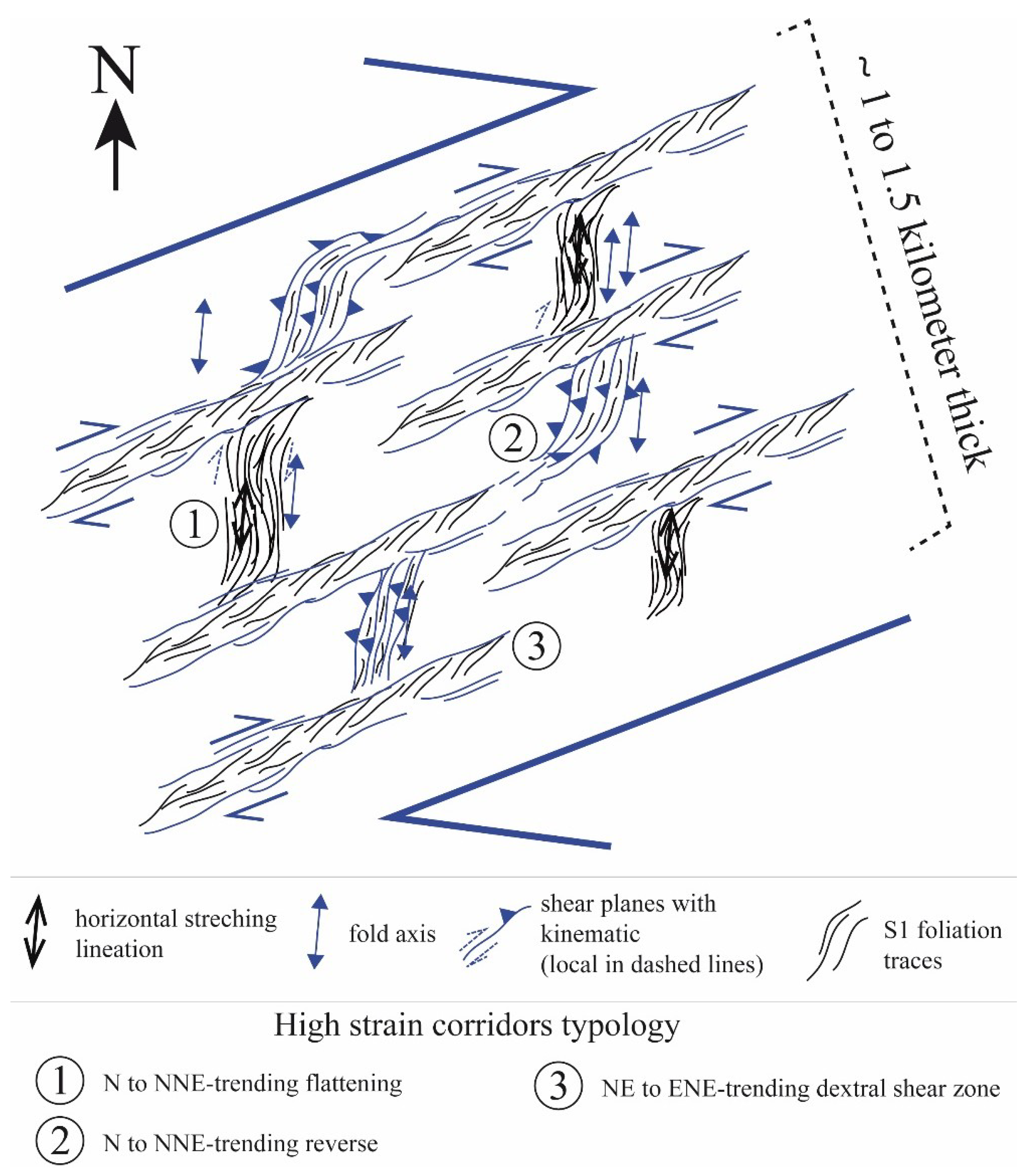
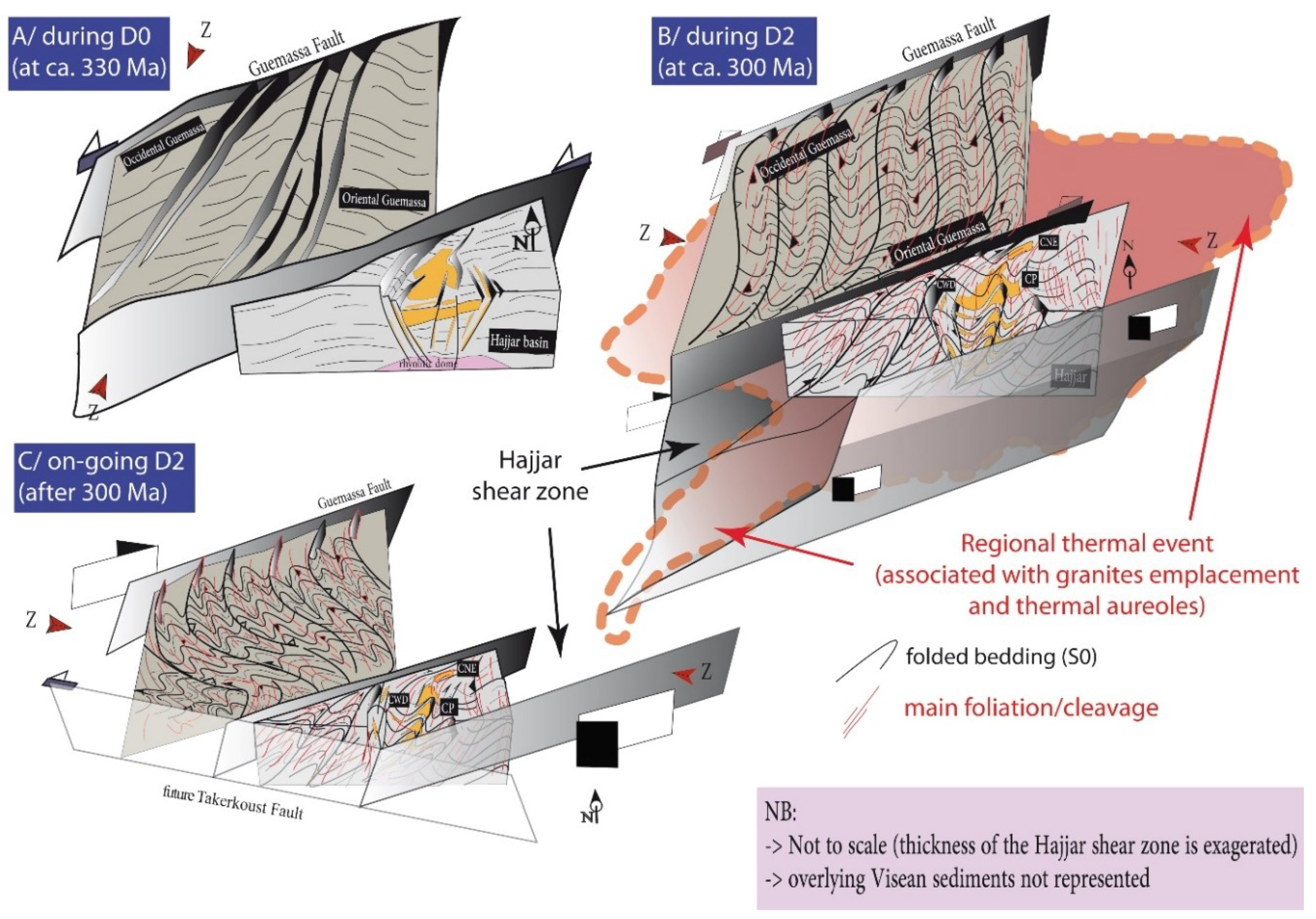
© 2018 by the authors. Licensee MDPI, Basel, Switzerland. This article is an open access article distributed under the terms and conditions of the Creative Commons Attribution (CC BY) license (http://creativecommons.org/licenses/by/4.0/).
Share and Cite
Admou, S.; Branquet, Y.; Badra, L.; Barbanson, L.; Outhounjite, M.; Khalifa, A.; Zouhair, M.; Maacha, L. The Hajjar Regional Transpressive Shear Zone (Guemassa Massif, Morocco): Consequences on the Deformation of the Base-Metal Massive Sulfide Ore. Minerals 2018, 8, 435. https://doi.org/10.3390/min8100435
Admou S, Branquet Y, Badra L, Barbanson L, Outhounjite M, Khalifa A, Zouhair M, Maacha L. The Hajjar Regional Transpressive Shear Zone (Guemassa Massif, Morocco): Consequences on the Deformation of the Base-Metal Massive Sulfide Ore. Minerals. 2018; 8(10):435. https://doi.org/10.3390/min8100435
Chicago/Turabian StyleAdmou, Safouane, Yannick Branquet, Lakhlifi Badra, Luc Barbanson, Mohamed Outhounjite, Abdelali Khalifa, Mohamed Zouhair, and Lhou Maacha. 2018. "The Hajjar Regional Transpressive Shear Zone (Guemassa Massif, Morocco): Consequences on the Deformation of the Base-Metal Massive Sulfide Ore" Minerals 8, no. 10: 435. https://doi.org/10.3390/min8100435
APA StyleAdmou, S., Branquet, Y., Badra, L., Barbanson, L., Outhounjite, M., Khalifa, A., Zouhair, M., & Maacha, L. (2018). The Hajjar Regional Transpressive Shear Zone (Guemassa Massif, Morocco): Consequences on the Deformation of the Base-Metal Massive Sulfide Ore. Minerals, 8(10), 435. https://doi.org/10.3390/min8100435




